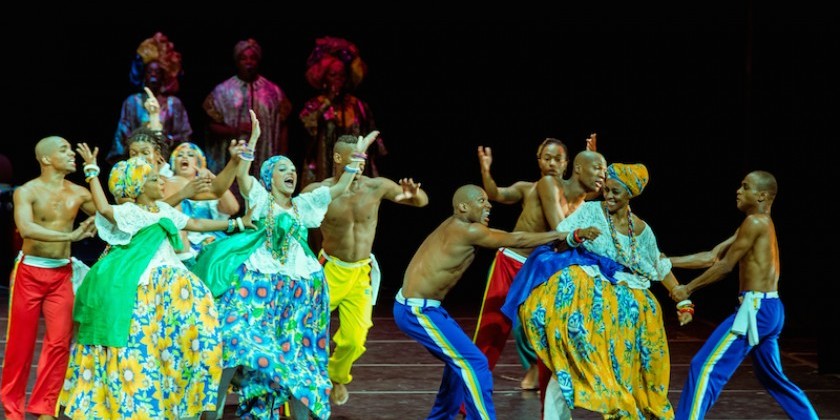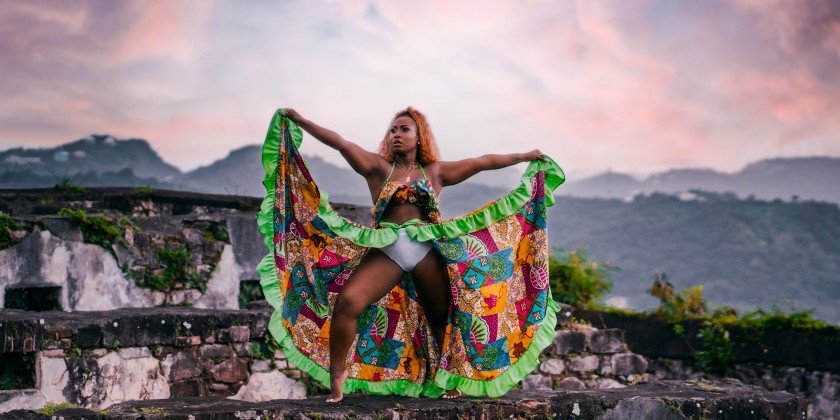A DAY IN THE LIFE OF DANCE: Participants in DanceAfrica 2021 on Their Inspiration from the Divine Voices of Haitian Vodou

Abdel Salaam, HaitiDansco, Asé Dance Theatre Collective, The Fritzation Experience, Rara Too Limen, BAM/Restoration DanceAfrica Ensemble, DanceAfrica Spirit Walkers
DanceAfrica 2021
Virtual at BAM.org/danceafrica
Premieres May 29th and available through June 14th
Pay-what-you-wish pricing: $10, $25, $44
Artistic Director Abdel R. Salaam // Film Production by Chimaeric Motion Pictures
Featuring Performances by HaitiDansco (Cap Haitien, Haiti); Asé Dance Theatre Collective (Brooklyn); The Frtization Experience (Brooklyn); Rara Tou Limen (Oakland); BAM/Restoration DanceAfrica Ensemble (Brooklyn); DanceAfrica Spirit Walkers (Brooklyn)
“Vwa Zanset Yo: Y’ap Pale N’ap Danse!” (Ancestral Voices…They Speak, We Dance!” in Haitian-Creole) is the 2021 theme of Brooklyn Academy of Music’s 44th annual presentation of DanceAfrica.
Performed virtually due to COVID-19, this year’s festival features four dance films that highlight the characteristics of lwas, the divine spiritual forces in Haitian Vodou.
Abdel R. Salaam, DanceAfrica’s artistic director, was introduced to Haitian folkloric dance when performing in the company of his predecessor and DanceAfrica’s founder, the late Baba Chuck Davis. He was also fortunate to study with master teachers such as Lee “Aco” Thompson beginning in the early 1970s.

When asked why he chose to have Haiti as the focus of DanceAfrica, Salaam says, “Haitian folkloric dance is one of the most profound forms of vernacular dance and cultural expression that we have within the diaspora in the new world. It links us directly to the African continent in language, movement, nuance, and texture. When we call upon, or we relate to those particular divine forces of nature as manifested in dance and music, there's an inner voice and empowerment that begins to rise within our own being and understanding. I'm continually empowered by the essence of that culture.”
Salaam’s choreography, “Ouvé Le Pòt La,” performed to Haitian house music by Jeff Pierre and featuring the BAM/Restoration DanceAfrica Ensemble and the DanceAfrica Spirit Walkers, will be his contribution to the festival.

Cap-Haitien-based HaitiDansco, founded in New York City in 2004 by internationally-trained choreographer, Dieufel Lamisere, will share a dance that serves as an offering to Agwe. Agwe is the lwa who is the king of the sea and protector of fishermen and sailors. “Haiti is the first Black country that fought for its freedom and won, setting an example for all Black nations. It is time for us to show America and the world the real value and true side of Haiti, and not what you see in the news,” says Lamisere. “Haiti has so much to offer.”
The Fritzation Experience, led by Haitian-American choreographer Fritzlyn “Fritz” Hector presents “Steel Standing,” a film that draws upon dances for Ogou, a family of spirits that represent iron and also embody the principles of power and justice. Hector, a former principal dancer with Salaam’s Forces of Nature, is a longtime participant and performer in DanceAfrica. She chose to center her work on Ogou to highlight a sense of power. “There’s strength in numbers and Ogou evokes that as a warrior spirit,” says Hector. “Especially given the times that we’re living in, I wanted to say we’re still standing strong and resilient. Let’s live in strength.”

Founded by Portsha Jefferson, the Bay Area-based Haitian folkloric dance company, Rara Tou Limen, will offer a dance centered on the lwa Agwe. Jefferson was inspired by a trip she and her company members made in 2019 to Benin in West Africa—the birthplace of Vodou. Jefferson, who is a practitioner of Vodou says, “I want audiences to see that Vodou is an honorable and respectable tradition. I want them to know that the dance they're seeing is just one part of it, a beautiful part. I would like for people to leave DanceAfrica honoring and celebrating it, and knowing that it is a healing tradition—a sacred tradition.”

The neo-folkloric ensemble, Asé Dance Theater Collective, led by its founder, Adia Whitaker, will present a piece centered on the Gede, the lwa of the ancestral dead who personify sexual regeneration and are also the guardian of children. Whitaker invited other Haitian artists, one being master teacher, Lionel St. Cyrin, to be a part of her work, and found the process of creation to be transformative. “I wanted the film to feel resilient. I wanted it to feel stunning. I wanted to make people laugh...For us though, it was the first time [since the start of the pandemic that] we had all been in the same place dancing with other people. So, the survival dance and music that we've been performing for so long—the medicine that heals our people—is now healing us.”













